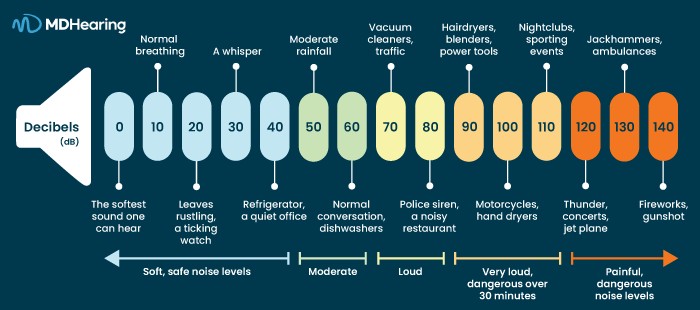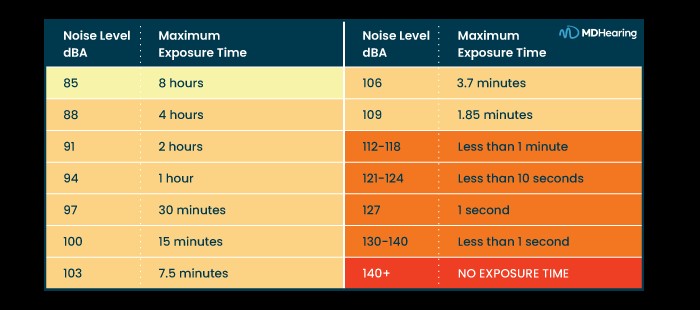Understanding sound levels is crucial for protecting your hearing. What Is 90 Decibels Compared To in everyday life, and what are the potential risks associated with exposure? This article from COMPARE.EDU.VN breaks down the comparison, offering insights into safe exposure times and practical tips for safeguarding your hearing health. Explore the details to gain a comprehensive understanding of decibel levels, sound intensity, and noise-induced hearing loss (NIHL).
1. Understanding Sound Measurement: Decibels Explained
Sound intensity, or noise level, is measured in decibels (dB). The higher the decibel number, the louder the sound. But what does a specific decibel level really mean in terms of everyday sounds? Understanding this scale is the first step in protecting your hearing.
1.1. The Decibel Scale: From Silence to Pain
The decibel scale ranges from 0 dB, the softest sound a person with normal hearing can perceive, to 140 dB, the threshold of pain. This logarithmic scale means that each increase of 10 dB represents a tenfold increase in sound intensity.
- 0 dB: The threshold of hearing
- 10 dB: Normal breathing
- 20 dB: Rustling leaves, ticking watch
- 30 dB: A whisper
- 40 dB: Refrigerator hum, quiet office
- 50 dB: Moderate rainfall
- 60 dB: Normal conversation, dishwasher
- 70 dB: Vacuum cleaner, traffic noise
- 80 dB: Police car siren, noisy restaurant
- 90 dB: Hair dryer, blender, power tools
- 100 dB: Motorcycle, hand dryer
- 110 dB: Nightclub, sporting event
- 120 dB: Thunder, concert, jet plane takeoff
- 130 dB: Jackhammer, ambulance siren
- 140 dB: Fireworks, gunshot (threshold of pain)
1.2. The Significance of A-Weighted Decibels (dBA)
A-weighted decibels (dBA) are used to measure sound levels while taking into account the human ear’s sensitivity to different frequencies. Unlike standard dB measurements, dBA emphasizes frequencies in the middle of the hearing range, where human ears are most sensitive, and de-emphasizes very low and very high frequencies. This weighting provides a more accurate representation of the perceived loudness and potential for hearing damage.
2. 90 Decibels: What Does It Sound Like?
At 90 decibels, sounds are loud enough to potentially cause hearing damage with prolonged exposure. Common examples of 90 dB sounds include:
- Hair dryers
- Blenders
- Power tools (drills, saws, etc.)
- Lawnmowers
2.1. Comparing 90 dB to Other Common Sounds
To put 90 dB into perspective, let’s compare it to other everyday sounds:
| Sound Source | Decibel Level (dB) | Potential Risk with Prolonged Exposure |
|---|---|---|
| Normal Breathing | 10 | None |
| Whisper | 30 | None |
| Normal Conversation | 60 | None |
| Vacuum Cleaner | 70 | Possible after very long exposure |
| Noisy Restaurant | 80 | Possible after prolonged exposure |
| Hair Dryer | 90 | Yes, after extended exposure |
| Motorcycle | 100 | Yes, relatively quickly |
| Concert | 120 | Immediate risk |


This comparison illustrates that while sounds below 80 dB are generally safe, continuous exposure to 90 dB and above can lead to hearing damage over time.
2.2. Real-World Examples of 90 Decibel Scenarios
Understanding the context in which you encounter 90 dB sounds is crucial. Consider these scenarios:
- Home: Using a hair dryer every morning for 15-20 minutes.
- Kitchen: Running a blender for several minutes each day to prepare smoothies.
- Workshop: Operating power tools for extended periods without hearing protection.
- Outdoors: Using a lawnmower or leaf blower for yard work.
Each of these scenarios presents a risk of hearing damage if proper precautions are not taken.
3. The Risks of Exposure to 90 Decibels
Exposure to loud noise, including 90 dB sounds, can damage the delicate hair cells in the inner ear, leading to noise-induced hearing loss (NIHL). NIHL is often gradual and painless, making it difficult to detect until significant damage has occurred.
3.1. Noise-Induced Hearing Loss (NIHL)
NIHL is a common and preventable condition. It results from prolonged or repeated exposure to loud sounds, which can damage the hair cells in the cochlea, the part of the inner ear responsible for transmitting sound signals to the brain. Once these hair cells are damaged, they cannot regenerate, leading to permanent hearing loss. According to research from the National Institute on Deafness and Other Communication Disorders (NIDCD), approximately 26 million adults in the U.S. have NIHL.
3.1.1. Symptoms of NIHL
- Difficulty understanding speech
- Ringing in the ears (tinnitus)
- Increased sensitivity to sound (hyperacusis)
- Muffled hearing
3.2. Safe Exposure Times at 90 Decibels
According to the National Institute for Occupational Safety and Health (NIOSH), the maximum recommended exposure time to 85 dBA is 8 hours. For every 3 dBA increase, the safe exposure time is halved. Therefore, at 88 dBA, the safe exposure time is 4 hours, and at 91 dBA, it is 2 hours. While there’s no exact recommendation for 90 dBA, it’s advisable to limit exposure to under 2 hours without hearing protection to minimize the risk of hearing damage.
| Noise Level (dBA) | Maximum Exposure Time |
|---|---|
| 85 | 8 hours |
| 88 | 4 hours |
| 91 | 2 hours |
| 94 | 1 hour |
3.3. Factors Affecting Hearing Damage
Several factors can influence the extent of hearing damage caused by noise exposure:
- Intensity of the Sound: Louder sounds cause more damage.
- Duration of Exposure: Longer exposure times increase the risk.
- Frequency of Exposure: Repeated exposure can compound the damage.
- Individual Susceptibility: Some people are more sensitive to noise than others.
- Distance from the Sound Source: Closer proximity increases the intensity of the sound.
4. Protecting Your Hearing: Practical Strategies
Preventing NIHL involves minimizing exposure to loud sounds and using hearing protection when exposure is unavoidable.
4.1. Strategies for Reducing Noise Exposure
- Keep the Volume Down: When using headphones or listening to music, keep the volume at a safe level. A good rule of thumb is to keep the volume below 60% of the maximum.
- Move Away from Loud Sounds: Distance yourself from loud sound sources, such as speakers at concerts or noisy machinery.
- Limit Time in Noisy Environments: Take breaks from noisy environments to give your ears a rest.
- Modify Your Environment: Use soundproofing materials to reduce noise levels in your home or workplace.
4.2. Types of Hearing Protection
- Earplugs: Affordable and convenient, earplugs come in various types, including foam, silicone, and custom-molded options. They reduce noise levels by blocking the ear canal.
- Earmuffs: These provide a tighter seal around the ears, offering greater protection than earplugs. They are ideal for high-noise environments.
- Noise-Canceling Headphones: While primarily designed for music listening, these headphones also reduce ambient noise levels, making them suitable for travel and noisy environments.
- Musicians’ Earplugs: Engineered to reduce noise levels while maintaining sound quality, these are perfect for attending concerts or playing music.
4.3. How to Choose the Right Hearing Protection
When selecting hearing protection, consider the following factors:
- Noise Reduction Rating (NRR): This indicates the level of noise reduction provided by the protection. Higher NRR values offer greater protection.
- Comfort: Choose protection that fits comfortably and can be worn for extended periods.
- Ease of Use: Select a product that is easy to insert, remove, and maintain.
- Specific Needs: Consider the specific environment and type of noise you will be exposed to.
4.4. Proper Use of Hearing Protection
To ensure effective hearing protection:
- Insert Earplugs Correctly: Follow the manufacturer’s instructions for proper insertion.
- Ensure a Tight Seal: Earmuffs should fit snugly around the ears, creating a complete seal.
- Maintain Cleanliness: Clean hearing protection regularly to prevent infections.
- Replace Worn Items: Replace earplugs and earmuffs when they become worn or damaged.
5. Monitoring Your Hearing Health
Regular hearing tests are essential for detecting early signs of hearing loss and monitoring your hearing health.
5.1. Recognizing Early Signs of Hearing Loss
Be aware of the following signs that may indicate hearing loss:
- Difficulty hearing conversations in noisy environments
- Ringing in the ears (tinnitus)
- Frequently asking others to repeat themselves
- Turning up the volume on the television or radio
- Feeling that speech sounds muffled
5.2. The Importance of Regular Hearing Tests
Regular hearing tests can help identify hearing loss early, allowing for timely intervention and management. The American Speech-Language-Hearing Association (ASHA) recommends that adults have their hearing tested every 10 years until age 50, and then every three years thereafter. Individuals who are regularly exposed to loud noise should have more frequent testing.
5.3. Options for Hearing Tests
- Audiologist: A professional who specializes in diagnosing, treating, and managing hearing and balance disorders.
- Online Hearing Tests: While not as comprehensive as professional tests, online tests can provide a quick assessment of your hearing.
- Hearing Clinics: Facilities that offer hearing tests and consultations.
- Primary Care Physician: Your doctor can perform basic hearing screenings and refer you to a specialist if needed.
6. Debunking Myths About Decibel Levels and Hearing Loss
There are several misconceptions about decibel levels and hearing loss. Let’s clarify some of the most common ones:
- Myth: Only extremely loud noises cause hearing damage.
- Fact: Prolonged exposure to moderately loud noises (e.g., 85 dB) can also cause hearing loss over time.
- Myth: Hearing loss only affects older people.
- Fact: People of all ages can experience hearing loss due to noise exposure, genetics, or other factors.
- Myth: If my ears aren’t ringing, my hearing isn’t being damaged.
- Fact: Hearing damage can occur gradually and painlessly, even without ringing in the ears (tinnitus).
- Myth: Hearing loss is reversible.
- Fact: Noise-induced hearing loss is typically permanent, as damaged hair cells cannot regenerate.
7. Using COMPARE.EDU.VN to Make Informed Decisions
At COMPARE.EDU.VN, we understand the challenges of making informed decisions in a world filled with countless options. Our platform is designed to provide comprehensive and objective comparisons across a wide range of products, services, and ideas. Whether you’re a student comparing universities, a consumer evaluating different brands, or a professional seeking the best technology solutions, COMPARE.EDU.VN is your trusted resource for making confident choices.
7.1. How COMPARE.EDU.VN Simplifies Decision-Making
Our detailed comparison articles offer clear, unbiased assessments, helping you weigh the pros and cons of each option. We provide side-by-side comparisons of features, specifications, prices, and user reviews, ensuring you have all the necessary information at your fingertips.
7.2. Addressing Customer Challenges
We recognize the difficulties customers face when comparing options:
- Objective and Comprehensive Comparisons: Our articles provide unbiased assessments, ensuring you receive balanced information.
- Detailed Information: We present clear advantages and disadvantages for each option, enabling you to make informed decisions.
- Feature and Specification Comparisons: We compare essential features, specifications, and prices, highlighting key differences.
- User Reviews and Expert Opinions: We incorporate feedback from users and experts, offering real-world insights.
- Identifying the Best Fit: Our comparisons help you determine the best option based on your needs and budget.
7.3. Real-World Examples
Consider the following scenarios:
- Choosing Headphones: COMPARE.EDU.VN provides detailed comparisons of noise-canceling headphones, highlighting differences in sound quality, comfort, battery life, and noise reduction effectiveness.
- Selecting Power Tools: Our power tool comparisons offer insights into performance, durability, features, and user reviews, helping you choose the right tools for your projects.
- Evaluating Kitchen Appliances: We compare blenders, providing information on power, features, capacity, and customer satisfaction, ensuring you select the best blender for your needs.
8. Conclusion: Protecting Your Hearing in a Noisy World
Understanding decibel levels and the risks of noise exposure is crucial for protecting your hearing health. Sounds at 90 decibels, common in everyday life, can cause hearing damage with prolonged exposure. By taking proactive steps to reduce noise exposure, using hearing protection, and monitoring your hearing health, you can prevent noise-induced hearing loss and maintain your hearing for years to come. Visit COMPARE.EDU.VN to explore detailed comparisons of products and services designed to help you make informed decisions and safeguard your well-being.
Are you struggling to compare different options and make the right choice? Visit COMPARE.EDU.VN today for comprehensive, objective comparisons that empower you to make confident decisions. Whether you’re evaluating products, services, or ideas, we provide the information you need to choose wisely.
Address: 333 Comparison Plaza, Choice City, CA 90210, United States
WhatsApp: +1 (626) 555-9090
Website: COMPARE.EDU.VN
9. Frequently Asked Questions (FAQ)
1. What is a decibel (dB)?
A decibel (dB) is a unit used to measure the intensity or loudness of a sound. The higher the decibel level, the louder the sound.
2. What is considered a safe decibel level?
The U.S. Environmental Protection Agency (EPA) recommends maintaining environmental noises below 70 dBA over 24 hours to prevent noise-induced hearing loss (NIHL).
3. What are A-weighted decibels (dBA)?
A-weighted decibels (dBA) are used to measure sound levels while taking into account the human ear’s sensitivity to different frequencies. It emphasizes frequencies in the middle of the hearing range and de-emphasizes very low and very high frequencies.
4. What is noise-induced hearing loss (NIHL)?
Noise-induced hearing loss (NIHL) is hearing loss caused by prolonged or repeated exposure to loud sounds. It damages the hair cells in the inner ear, leading to permanent hearing loss.
5. What are common sources of 90 dB sounds?
Common sources of 90 dB sounds include hair dryers, blenders, power tools, and lawnmowers.
6. How long can I be exposed to 90 dB without hearing protection?
It’s advisable to limit exposure to under 2 hours without hearing protection to minimize the risk of hearing damage.
7. What are the signs of hearing loss?
Signs of hearing loss include difficulty hearing conversations in noisy environments, ringing in the ears (tinnitus), frequently asking others to repeat themselves, turning up the volume on the television or radio, and feeling that speech sounds muffled.
8. How can I protect my hearing in noisy environments?
You can protect your hearing by keeping the volume down, moving away from loud sounds, limiting time in noisy environments, and wearing hearing protection such as earplugs or earmuffs.
9. How often should I get my hearing tested?
The American Speech-Language-Hearing Association (ASHA) recommends that adults have their hearing tested every 10 years until age 50, and then every three years thereafter. Individuals who are regularly exposed to loud noise should have more frequent testing.
10. Where can I find more information on comparing products and services?
Visit compare.edu.vn for comprehensive and objective comparisons across a wide range of products, services, and ideas.
